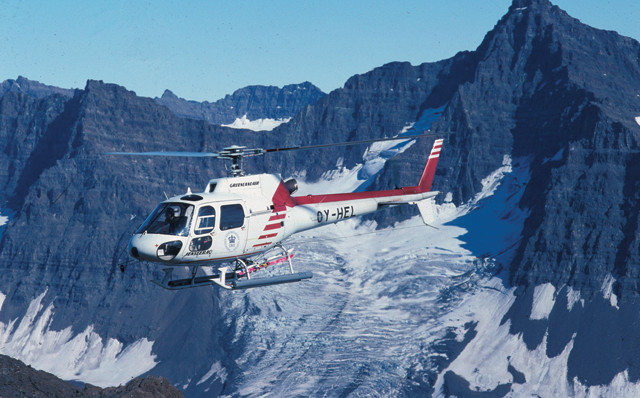
by Mary Caperton Morton Thursday, December 14, 2017

Kilometers-thick layers of volcanic rock that formed as the North Atlantic ocean basin opened between Greenland and Norway make for stunning mountain backdrops in eastern Greenland today. Carbon emissions that accompanied this volcanism may have caused the large-scale global warming of the Paleocene-Eocene Thermal Maximum. Credit: Michael Storey, Natural History Museum of Denmark.
Roughly 56 million years ago, global temperatures rose 5 degrees Celsius within a few thousand years in an event called the Paleocene-Eocene Thermal Maximum (PETM). Scientists have often attributed the relatively rapid warming of the PETM — frequently used as an analogue for understanding modern warming trends — to large-scale biogenic methane emissions from seafloor reservoirs. But in a new study, researchers tracking carbon and boron isotopes preserved in the shells of tiny marine creatures called foraminifera, or forams, question the conventional wisdom, instead pointing to a volcanic source for the carbon emitted during the PETM.
“We’ve known for a long time that carbon emissions during the PETM were high, but we didn’t know the source of all that carbon,” says Marcus Gutjahr, a paleoclimatologist at the GEOMAR Helmholtz Center for Ocean Research in Germany and lead author of the new study in Nature. Gutjahr and his colleagues sampled a sediment core collected from the North Atlantic seafloor that contained foram shells, which preserve a record of carbon and boron isotopes taken up from seawater. Carbon isotopes are a classic tool for studying ocean chemistry, Gutjahr says, but using boron isotopes is relatively new.
By tracking the changing ratios of carbon and boron isotopes in the shells, the team found that the pH of the North Atlantic fell significantly through the PETM, dropping by about 0.3 pH units within 25,000 years of the onset. They then input the data into a global climate model designed by co-author Andy Ridgwell of the University of California, Riverside. The model suggested that the pH drop was caused by a massive carbon input — one even larger than previously thought — into the atmosphere; much of this carbon made its way into the ocean, acidifying the seawater. The oceans and atmosphere needed more than 150,000 years to recover.
Carbon from different sources, such as volcanic or deep-sea methane, has different isotopic signatures. Carbon from volcanoes, for example, is isotopically heavy, meaning there is a relatively high proportion of carbon-13 to carbon-12. Biogenic methane, on the other hand, “has a very light isotopic signature,” Gutjahr says. The carbon isotopic signatures his team found in the foram shells were consistently heavy, and the global climate model confirmed that a substantial volume of carbon must have been emitted from a mostly volcanic source — likely from the eruptions accompanying the opening of the North Atlantic between Greenland and Norway at the time, the researchers suggested.
“The PETM is probably the closest analogue we have to future warming in the geologic record: It was an abrupt warming caused by a release of carbon,” says Katrin Meissner, a climatologist at the University of New South Wales in Australia who was not involved in the new study but wrote an accompanying commentary in Nature. But it doesn’t offer a direct comparison because the PETM was “also very different from today,” she says. “The climate was already much warmer at the onset of the event, and the release [of carbon] was much slower than it is today” — by a factor of at least 10, she says. That gave ecosystems more time to adapt, and gave feedback mechanisms that moderated the climate, such as carbon sequestration, more time to kick in, she adds.
The fossil record shows that although some marine organisms were affected by the changing climate in the PETM, extinctions did not occur en masse, indicating that most species were able to adapt, Gutjahr says. “We can try to draw comparisons between the PETM and today, but we are emitting carbon at a much faster rate today,” he says. “We’re running the PETM in fast-forward, which is very concerning.”
© 2008-2021. All rights reserved. Any copying, redistribution or retransmission of any of the contents of this service without the expressed written permission of the American Geosciences Institute is expressly prohibited. Click here for all copyright requests.